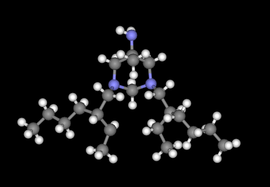Hexetidine
 | |
| Clinical data | |
|---|---|
| AHFS/Drugs.com | International Drug Names |
| Pregnancy category |
|
| Routes of administration | Topical (mouthwash) |
| ATC code | A01AB12 (WHO) G01AX16 (WHO) |
| Legal status | |
| Legal status |
|
| Identifiers | |
| |
| CAS Number |
141-94-6 |
| PubChem (CID) | 3607 |
| DrugBank |
DB08958 |
| ChemSpider |
32697287 |
| UNII |
852A84Y8LS |
| ChEMBL |
CHEMBL144673 |
| ECHA InfoCard | 100.005.012 |
| Chemical and physical data | |
| Formula | C21H45N3 |
| Molar mass | 339.602 g/mol |
| 3D model (Jmol) | Interactive image |
| |
| |
| | |
Hexetidine (Latin: Hexetidinum) is an anti-bacterial and anti-fungal agent commonly used in both veterinary and human medicine. It is a local anesthetic, astringent and deodorant and has antiplaque effects.[1]
Hexetidine is the medicinal ingredient in Sterisol, which is labelled for the symptomatic treatment of streptococcal pharyngitis ('strep throat'), tonsillitis, pharyngitis, laryngitis, gingivitis, ulcerative stomatitis, oral thrush and Vincent's angina; postoperative hygiene following tonsillectomy, throat or oral surgery.
In the UK, hexetidine is the active ingredient in the medicated mouthwash branded Oraldene. In Canada, hexetidine is the active ingredient in the medicated mouthwash branded Steri/sol. The product called Sterisol in Canada is no longer available it has been discontinued. This is produced by Mcneil, a division of Johnson & Johnson. Oraldene contains 0.1 g/100 ml of hexetidine. In some European countries, the gargle solution and mouth spray in bottles of 40 ml named Hexoral (by Mcneil) also contains 0.2% Hexetidine as its active compound. Hexetidine can also be found in the mouthwash Bactidol (by Mcneil) which is sold in many Asian countries. In Germany, hexetidine vaginal suppositories branded Vagi-Hex are in use for vaginal antisepsis. They are also used in late pregnancy for reducing neonatal infectious mortality and morbidity due to group B streptococcal infections;[2] nonetheless, hexetidine is to be used only with care during pregnancy, and its vaginal use is counter-indicated in the first three months of pregnancy.[3]

References
- ↑ Kapić E, Becić F, Becić E (2002). "Hexetidine--an oral antiseptic". Med Arh. 56 (1): 43–8. PMID 11917691.
- ↑ Weidinger H, Passloer HJ, Kovacs L, Berle B (November 1991). "[The advantage of preventive vaginal antisepsis with hexetidine in obstetrics and gynecology]". Geburtshilfe Frauenheilkd (in German). 51 (11): 929–35. doi:10.1055/s-2008-1026238. PMID 1773929.
- ↑ Vagi-Hex: Gegenanzeigen (Vagi-Hex: Counterindications, in German language)
External links
| Wikimedia Commons has media related to Hexetidine. |